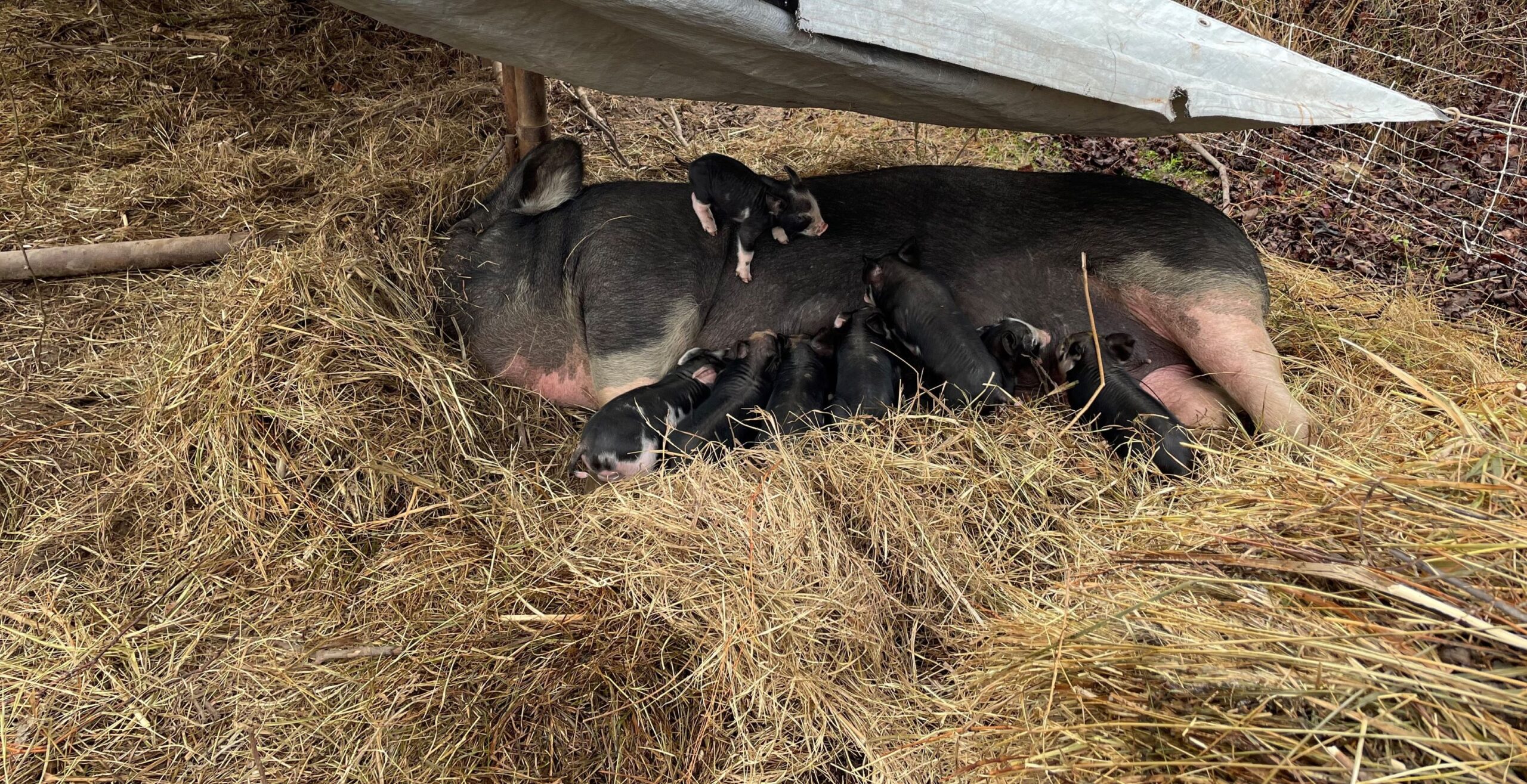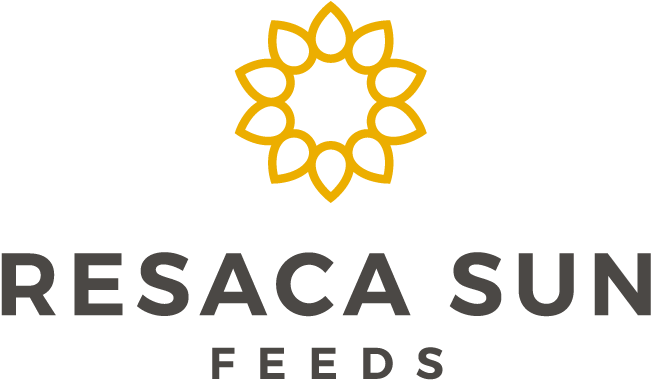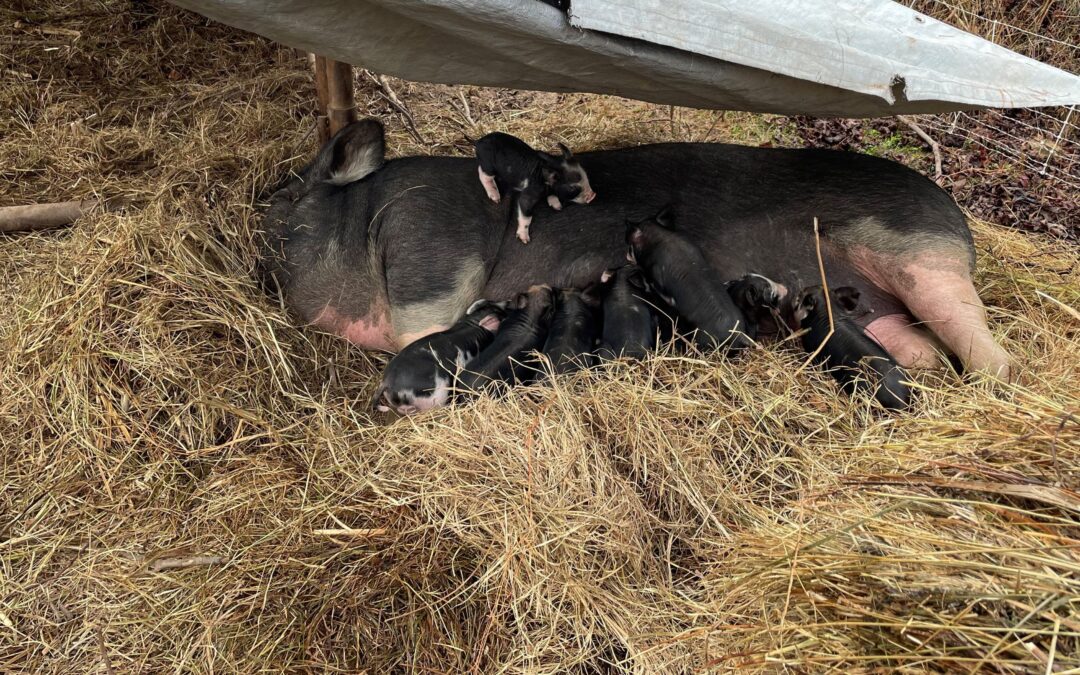
The topic of flush feeding (or flushing) comes up amongst sheep and goat farmers more often than it does for sows. I first learned about flush feeding sows from a farmer in North Carolina, which has led me down a sow flush feeding rabbit hole. What does “flush feeding” mean? Flush Feeding is increasing feed intake for a short period of time. This feeding process increases the nutrients the female is consuming with the goal of increasing ovulation rates so that litter sizes increase. Nutrition is crucial in the reproductivity capability of all livestock. An undernourished animal will not cycle and will have difficulty getting pregnant; therefore, the process of increasing nutrition to increase litter size seems logical.
Flush Feeding sows is not a new concept yet, there is conflicting information on if Flush Feeding is beneficial. Research suggests increasing a sow’s feed intake to 6-8 lbs. of feed per head per day for 2-3 weeks before breeding improves her litter size (Shannon, n.d.). However, another study in 2020 showed that flush feeding gilts before insemination did have a higher ovulation rate, but reduced embryo survival. (Mallmann et al., 2020). This study was focused on Gilts. Gilts are bred at 280-300 lbs. or after their 3rd estrus. Another study of nineteen pig farms in the Netherlands found that sows fed 1 kilogram (2.2 lbs.) of extra feed per day during the insemination period resulted on average in a 45-gram (1.6 oz) higher birthweight of her piglets. While this isn’t necessarily increasing litter size, it is benefiting birthweight. Boosting the feed intake during this period therefore seems to be a valuable option for improving litters (TOPIGS Research: Flushing Sows Gives Higher Piglet Birthweight, n.d.).
One of the key things in breeding is good nutrition and observing your sow’s body condition. Good body condition will lead to good reproductive performance. The profitability of farms depends heavily on the reproductive performance of sows (Veterinaria Digital S.A., 2022). The chosen methodology of feeding a sow throughout her entire life has a huge impact on the birthweights of her piglets. (TOPIGS Research: Flushing Sows Gives Higher Piglet Birthweight, n.d.). Increasing feed intake during the breeding period places the sow in a positive energy state, which usually increases the number of ovulated eggs. This results in an increase in litter size (Swine Nutrition | 1 Extension, 2021). A question often asked is, “when should I switch my sows to a sow feed? The answer is: 2-3 weeks before breeding. Sow feed is higher in vitamins, specifically choline, calcium, and phosphorus. Choline is involved in several metabolic functions and is important during breeding, gestation, and lactation. For the sow, choline helps with improving conception rate, farrowing rate, and litter size. It’s shown to improve the birth weight of piglets, neonatal piglet uniformity and litter performance during lactation. (Zhong et al., 2022)
If the practice of flushing interests you, consider using a sow feed to flush. The reasoning being sow feeds have more added nutrients. Sow feed has higher vitamin A, D, E levels as well as added choline along with additional calcium and phosphorus. These are all important nutrients for reproduction. For example, sows need 4x the amount of vitamin A during gestation and 5x the amount during lactation compared to feeder pigs. Our sow feeds (both the corn and soy based and corn and soy free sow feeds) meet vitamin requirements, including choline, for sows during gestation and lactation. However, the swine grower and swine finisher feeds have no added choline; therefore, these feeds are not ideal for breeding, pregnant, or lactating sows.
Overall, the practice of flush feeding sows focuses on providing additional nutrition to an ovulating sow, ensuring that her body has plenty of nutrients to support piglets during gestation and lactation. A sow in poor condition has less success during breeding and the piglet number will be lower since her body simply cannot support the added pressures of piglets. Lactation is the most nutrient demanding activity an animal experiences. It’s our responsibility to make sure we support our sow’s nutrient needs so she has healthy, happy piglets.
Have you tried flush feeding sows? If you have, how did it work for you? I’d love to hear more. Email me at [email protected]
References
Mallmann, A., Arend, L. S., De Oliveira, G. S., Mellagi, A. P. G., Da Rosa Ulguim, R., Bernardi, M. L., Bortolozzo, F. P., & Knox, R. V. (2020). Effects of flush feeding strategy before breeding on reproductive performance of modern replacement gilts: impacts on ovulation rate and litter traits. Journal of Animal Science, 98(6). https://doi.org/10.1093/jas/skaa186
Shannon, P. (n.d.). Nutrition and Feeding for Optimum Reproductive Performance. Oregon State Univeristy. Retrieved February 26, 2024, from https://anrs.oregonstate.edu/sites/agscid7/files/anrs/swinenutriforreprodperf.pdf
Swine Nutrition | 1 Extension. (2021, July 8). Extension. https://extension.unh.edu/resource/swine-nutrition
TOPIGS Research: Flushing sows gives higher piglet birthweight. (n.d.). https://www.thepigsite.com/articles/topigs-research-flushing-sows-gives-higher-piglet-birthweight
Veterinaria Digital S.A. (2022, July 26). Flushing technique in pigs. Veterinaria Digital. https://www.veterinariadigital.com/en/articulos/flushing-technique-in-pigs/#:~:text=This%20feeding%20strategy%20consists%20on,number%20of%20piglets%20per%20sow.
Zhong, W., Hu, L., Zhao, Y., Li, Z., Zhuo, Y., Jiang, X., Li, J., Zhao, X., Che, L., Feng, B., Lin, Y., Xu, S., Fang, Z., & Wu, D. (2022). Effects of dietary choline levels during pregnancy on reproductive performance, plasma metabolome and gut microbiota of sows. Frontiers in Veterinary Science, 8. https://doi.org/10.3389/fvets.2021.771228

